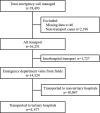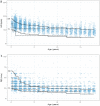The association between prehospital vital signs of children and their critical clinical outcomes at hospitals
- PMID: 35338242
- PMCID: PMC8956615
- DOI: 10.1038/s41598-022-09271-0
The association between prehospital vital signs of children and their critical clinical outcomes at hospitals
Abstract
Vital signs are important for patient assessment, but little is known about interpreting those of children in prehospital settings. We conducted an observational study to investigate the association between prehospital vital signs of children and their clinical outcomes in hospitals. We plotted the data of patients with critical outcomes on published reference ranges, such as those of healthy children to evaluate the clinical relevance. Of the 18,493 children screened, 4477 transported to tertiary hospitals were included in the analysis. The outcomes 12 h after being transported to a tertiary hospital were as follows: deceased, 41; hospitalization with critical deterioration events, 65; hospitalization without critical deterioration events, 1086; returned home, 3090; and unknown, 195. The reference ranges of the heart rates (sensitivity: 57.7%, specificity: 67.5%) and respiratory rates (sensitivity: 54.5%, specificity: 67.7%) of healthy children worked best to detect the critical outcomes. Therefore, the reference ranges of healthy children were concluded to be suitable in prehospital settings; however, excessive reliance on vital signs carried potential risks due to their limited sensitivities and specificities. Future studies are warranted to investigate indicators with higher sensitivities and specificities.
© 2022. The Author(s).
Conflict of interest statement
The authors declare no competing interests.
Figures



References
-
- O'Leary F, Hayen A, Lockie F, Peat J. Defining normal ranges and centiles for heart and respiratory rates in infants and children: A cross-sectional study of patients attending an Australian tertiary hospital paediatric emergency department. Arch. Dis. Child. 2015;100:733–737. doi: 10.1136/archdischild-2014-307401. - DOI - PMC - PubMed
Publication types
MeSH terms
LinkOut - more resources
Full Text Sources
Medical

